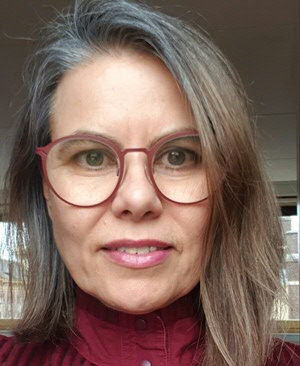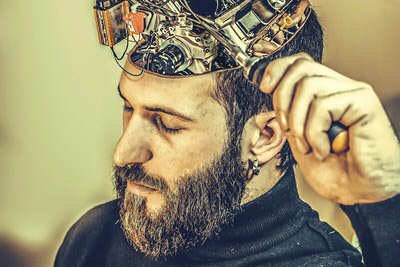The computer of the future

The computer of the future may well be made in Groningen – all thanks to the largest donation ever made (as far as we know) to a Dutch university by a former student. The graduate in question wishes to remain anonymous, and the total amount of the donation has yet to be announced. One thing we do know, however, is that the CogniGron research centre has received no less than €30 million for research on a new generation of energy-efficient computers. We spoke to director and professor Beatriz Noheda about the search for extremely efficient computers modelled on the human brain.
Text: Kirsten Otten / Illustration: Hippopx / Source: Broerstraat 5
Piezoelectricity is a dead end. That is what the physicist Beatriz Noheda was told when she followed her partner to the Netherlands in 2002 and enquired about career opportunities at Philips. Originally from Spain, Noheda had given up a fantastic job at Brookhaven National Laboratory in New York, and she now hoped to be able to use her knowledge and drive in the Netherlands. ‘That rejection was really disappointing, because I had done intensive research on this technology in New York. I truly believed in it, and I saw a direct link to the home appliances and medical applications that Phillips was working on at the time’.
CogniGron
Looking back, she can laugh about it all now. Noheda is currently a professor of functional nanomaterials at the UG, in addition to being the director and founder of the Groningen Cognitive Systems and Materials Center, CogniGron. This multidisciplinary research centre focuses on the development of new ‘smart’ materials that are needed for a new generation of computers that consume less energy and can process large amounts of data more quickly and easily.
‘We’d come up with the plan for CogniGron quite a while ago, but it ended up in a drawer due to a lack of funding’, recalls Noheda. ‘Until a few years ago, when an anonymous UG graduate made a €30 million donation for future-proof technical research in Groningen. So, we dusted off that plan and presented it. It was a nerve-racking period, but it ended well: our plan was approved!’
Around 15 PhD students are currently involved in CogniGron, along with 12 newly recruited professors. One current high priority is the development of a research programme for PhD students. In addition, the centre is cooperating intensively with colleagues in materials science, artificial intelligence, physics, mathematics and computer science.
Big data
Noheda gets straight to the point: ‘The computers we have today have come as far as they can. They can’t get any faster, and they can’t get any smaller’. This is the case, even as we are all generating an ever-increasing flow of data – big data – that could be used for so many valuable purposes.
‘If we could link all the hospital data in the world, it could dramatically speed up the development of medicines and vaccines. Linking seismographic data would make it easier to predict earthquakes accurately’, she illustrates. And then there’s the Internet of Things: self-driving cars, ‘smart’ houses full of sensors, in which the sun canopy communicates with the thermostat and the refrigerator alerts you when you run out of milk. ‘These ideas have been around for decades, but their development has virtually come to a standstill, because the current design of computers isn’t capable of processing so much data. And we still haven’t found a sustainable and feasible way to power the huge number of sensors we need’.
Super-efficient brain
‘In the current generation of computers, every bit of information is sent from transistor to transistor, step by step. That’s incredibly inefficient’, Noheda explains. ‘Computers must also perform two separate tasks at the same time: calculation and storage. These two systems work independently of each other, with data moving from one system to the other. This requires a lot of energy: all of today’s computers combined consume about 10% of the world’s energy’.
For the development of the new generation of computers, Noheda draws inspiration from the mechanics of the human brain. ‘Our brain is constantly bombarded with data, impulses that are classified and prioritized at breakneck speed’, she observes. ‘When you walk into this room, you see me straight away. A computer has to scan the whole room first. Our ability to focus is due to the fact that our brain cells are interconnected by thousands of links, thus forming parallel networks. Information is stored and processed simultaneously: that’s incredibly efficient’.

Noheda predicts that the computer of the future will be based on the same principle: one system for both computer memory and information processing. ‘To be able to mimic the workings of and connections between neurons, we need new systems and materials. Various research groups at the UG’s Zernike Institute for Advanced Materials (ZIAM) are studying materials that might be suitable for this purpose. We will also need to work with our colleagues at the Bernoulli Institute to learn how to integrate these materials into a computer’. Noheda stresses that this will not be an easy task, because, in addition to the many special properties the materials need to have, they must also be available on a sustainable basis.
Four-metre-high microscope
CogniGron is now very much up and running. ‘We already know a lot more about materials and how to manipulate them. The smaller the material is, the harder it is to make it do something, to control it. Our transmission electron microscope, which we bought in 2020, is a huge help. There are only about 10 of these in the whole world. We can use this four-metre-high microscope to study materials at the atomic level. This microscope uses an electron beam instead of light to create an image of a sample. The sample influences the trajectory of the electrons in the beam. The changes in that trajectory are then translated into a structure’.
Piezoelectricity
In the pursuit of energy-efficient computer systems (sensors), CogniGron is focusing its attention on piezoelectricity. You read that right – the technology that Philips had given up on years ago. ‘Piezoelectricity is a highly efficient property of some materials, where electricity is generated by vibrations’, explains Noheda. ‘The technology has already been successfully applied in ultrasound scans, airbags and inkjet printers, amongst other things, for many years. The main drawback is that PZT, the ideal material for piezoelectricity, consists mainly of lead. Given that lead is harmful to our health and the environment, we are now looking for a new material that is equally sensitive’.
The vibrations that generate piezoelectricity can be triggered by all sorts of mechanisms. Examples include loud noises, the weight of passing cars and people walking. ‘To investigate the latter, we set up a piezoelectric field lab in Zuidhorn last year. Pedestrians walking to or from the train station walk over tiles that produce an electric voltage when subjected to pressure. The piezo tiles can also be used as sensors, in addition to generating energy. This is a particularly interesting development, including for sustainable, future-proof computers!’
CV
Beatriz Noheda (1968) is a physicist. She received her PhD in 1996 from the Universidad Autonoma of Madrid, where she was an associate professor until 2000. She then went on to work as a researcher at the Brookhaven National Lab in New York and at VU Amsterdam. In 2004, she was appointed as a Rosalind Franklin Fellow at the UG and an associate professor of functional nanomaterials and received a Vidi grant from the Dutch Research Council (NWO). Noheda has been a full professor at the UG since 2014, and the founder/director of CogniGron since 2018.
More news
-
15 September 2025
Successful visit to the UG by Rector of Institut Teknologi Bandung
